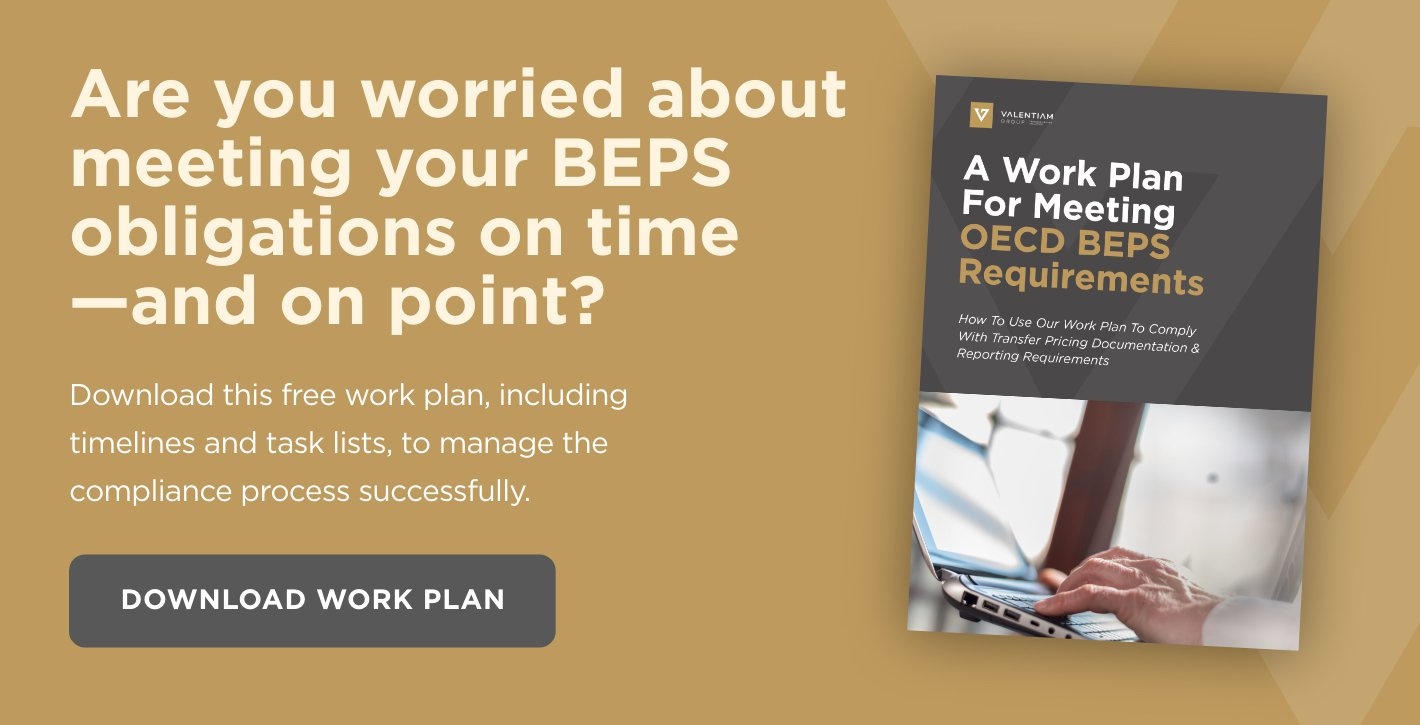Country By Country Reporting: An In-Depth Guide
Posted by Valentiam Group on June 30, 2021

In a previous article, we examined the Organisation for Economic Co-operation and Development (OECD) Base Erosion and Profit Shifting (BEPS) Action 13 guidelines for the transfer pricing master file and local files. Another component of Action 13 is country by country reporting (CBCR), which is the focus of this article.
Although the BEPS guidelines were adopted five years ago, complete clarity is lacking about which metrics tax authorities give the most focus; for example, U.S. country by country reporting guidance and clarifications are still being issued now, years after adoption of BEPS. The OECD country by country reporting guidance is itself being continually clarified.
In this article, we’ll examine the considerations that multinational companies need to take into account—U.S.-based companies in particular—when compiling country by country reporting.
6 Key Considerations For Country By Country Reporting
One of a taxpayer’s most critical goals in completing the CBCR form should be achieving consistency—both with other documentation reports as well as within the country by country report itself. Creating a schedule and procedures manual will help keep you on track and ensure you’re compiling information the same way every year. Completing a thorough check after compiling the report to make sure you’ve used all the correct codes and provided information in the proper format eliminates flags for closer scrutiny. Aside from being meticulous, keeping the following six considerations for CBCR on your radar will make the reporting process smoother and less stressful:
- Set up a system for managing notifications. Establishing a system will help you keep track of where notifications have been filed. In addition to tracking notifications, keep an eye on changes in requirements in the countries where you do business. For example, for tax years ending on or after December 31, 2019, Belgian entities of a multinational group no longer need to file annual notifications if there is no change to the information provided previously.
-
Monitor broad regulations. Currently, there is the potential that the European Union (EU) will require public country by country reports for companies headquartered in the EU with revenues over 750 million euros. Under the 2016 European Commission proposal, these companies would have to publicly report information such as revenue and profit. EU member states are still debating the issue.
Also, the OECD CRS XML schema Version 2.0, introduced in June 2019 with updated country codes and currencies and updated allowable lengths for certain values, is now in effect; the user guide indicates that Version 1.0 is not for use after January 1, 2021. Many countries have issued their own guidance on the requirement to use Version 2.0.
- Monitor local requirements. The following examples illustrate why it’s important to monitor the requirements in each country where you do business:
- Bosnia may request a local format instead of the version filed by the ultimate parent company (UPE).
- Beginning in 2020, Canadian UPEs are required to file electronically.
- Country by country reporting applies in Mongolia, Oman, Serbia, and Sri Lanka after January 1, 2020; Zambia is expected to announce reporting requirements soon.
-
Monitor the exchange of information. U.S. CBCR is not subject to the OECD’s Multilateral Competent Authority Agreement (MCAA) for the exchange of CBC reports. U.S. country by country reporting is instead governed by competent authority agreements (CAAs), which rely on double taxation conventions, tax information exchange agreements, or the Convention on Mutual Administrative Assistance in Tax Matters, which permit automatic exchanges of information.
Since the beginning of 2020, the U.S. has negotiated new agreements with Argentina, Curacao, and Germany (which previously had joint statements of intent to exchange), Monaco, and Singapore. The U.S. is currently in negotiations with Bulgaria—where the Bulgarian Tax Administration is contacting Constituent Entities in Bulgaria to discuss their local filing requirements—Cyprus, and France, where spontaneous exchange agreements have indicated the intent to exchange since 2017. Negotiations are also underway with Israel and Turkey, where the local filing deadline was extended to June 2021.
For more information on the automatic information exchange agreements each individual country has with other countries, the OECD has a helpful website with a frequently updated dropdown menu.
-
Pay attention to COVID-19 related extensions and issues. In some jurisdictions, timelines for notifications and/or filings were extended to accommodate pandemic disruptions. Jurisdictions that extended timelines include (but are not limited to) Belgium, Bosnia, Germany, Oman, South Africa, Australia, Guernsey, and the U.S. (to accommodate postponement of corporate tax return filing deadlines). The U.K. suspended penalties for late filing.
Consider how, or if, to explain unusual results due to COVID in your reports. Form 8975 has an “Additional Information” section for information related to the enterprise, and you can also use Schedule A to relate the impact of COVID on specific entities or in a particular jurisdiction. Discuss your strategy with your transfer pricing consultant and determine whether you want to make any COVID-specific explanations or disclosures. If you do, double-check to ensure consistency in your reporting between the master file, CBCR, and local files.
Also, be aware of the potential for CBCR to become more important in the wake of the pandemic, as governments may ramp up audits.
-
Find answers to any questions before filing your report. If you’re unsure, don’t rely on your interpretation of the guidelines; consult the authorities. The U.S. has guidance with fact patterns, as well as FAQs. The OECD frequently updates its guidance—at least annually and sometimes more often. These updates may provide the clarification you need.
In November 2019, the OECD provided a list of the common errors in reports up to that date, which included quite basic items such as missing TIN numbers or using the same TIN more than once, excessive rounding, entering amounts in the wrong columns, misaligning total revenues with related and unrelated party revenue totals, missing source information, incorrect jurisdiction codes, and other minor errors. Taxpayers should take caution not to raise any additional scrutiny of their CBCR by making one of these oversights.
In December 2019, the OECD issued country by country reporting guidance clarifying that automatic exchange of CBCR filed under local filing rules is not intended.
These updates and others issued since 2016 may provide answers to your questions, so stay current with guidance updates.
As the considerations above make clear, a structured regime for tracking notifications and filings—combined with continuous monitoring of broad and local guidelines and meticulous attention to detail—are the keys to maintaining reporting compliance and reducing the likelihood of audits.
Struggling to keep your BEPS reporting organized? Download our free template, A Work Plan For Meeting OECD BEPS Requirements.
Navigating Flux In Country By Country Reporting Guidance
The more consistency you can achieve in your reporting practices, the better. This is why it’s so important to compile internal operating procedures to ensure alignment with U.S. CBCR and OECD country by country reporting guidance. In a situation where you may have a new employee in the tax department compiling country by country reporting, it’s crucial that internal procedures exist to ensure they’re using information sourced consistently with prior years. For example, if you’ve previously counted seasonal employees in your reports, you should note this in an operating procedures manual so they aren’t left out this year.
As mentioned in the section about COVID-19 considerations, it’s important to recognize differences year-over-year and determine if you need to explain them. Deciding how much additional information you want to offer is a matter of strategy and discretion; if you determine that explanations are necessary, the “Additional Information” section on Form 8975 is where to report them.
When considering whether to include explanations, a decision driver is whether those disclosures will bring additional scrutiny to your report. If the disclosure is basic information available in public reports, it probably won’t raise any flags. In cases of large year-over-year discrepancies, those differences themselves are likely to result in more scrutiny of the report; in this situation, including a reasonable explanation in the report may reduce the likelihood of an audit.
Ultimately, given that both U.S. and OECD country by country reporting guidance is still being updated over time, the most important tasks are to stay on top of current guidance and follow it, file all notifications and reports on time, and meticulously review your reports before filing to ensure no discrepancies or errors.
Looking to the future, U.S. CBC reports (as well as CBC reports filed in other jurisdictions) may impact how authorities determine when to conduct audits. Jurisdictions are in the process of adopting new analytical capabilities to help identify issues for closer scrutiny and taxpayers for transfer pricing audits. As these capabilities come online over time, country by country reporting will continue to require close monitoring to ensure international tax compliance for companies with multinational operations.
Given the importance of country by country reporting, expert transfer pricing advice is crucial. A good transfer pricing specialist—like those on the experienced transfer pricing team at Valentiam—can help keep you on track and up to date on guidance. In addition, an expert advisor can help you determine when it’s beneficial to make additional disclosures—and what you should report.
We’ll help you navigate transfer pricing and policy changes.
Transfer pricing can be complex and confusing, but it doesn’t have to be that way.
Valentiam’s world-class transfer pricing specialists deliver innovative, thoughtful, and 100%-supportable strategies you can actually implement. It’s our goal to design economically sound strategies that your company can also easily administer. With the help of one of our seasoned experts, you can maximize company profits and minimize audit risk. Let’s talk about your unique transfer pricing challenges and how Valentiam can help solve them—schedule a free discovery call today.
Topics: Transfer pricing
Related Posts
Fred Johnson Joins Valentiam Group as Partner and Dispute Resolution Practice Leader
We are pleased to announce the addition of Fred Johnson as a partner at Valentiam Group.
Dr. Stephen Blough Joins Valentiam Group as Partner
We are pleased to announce the addition of Dr. Stephen Blough as a partner in the firm.


